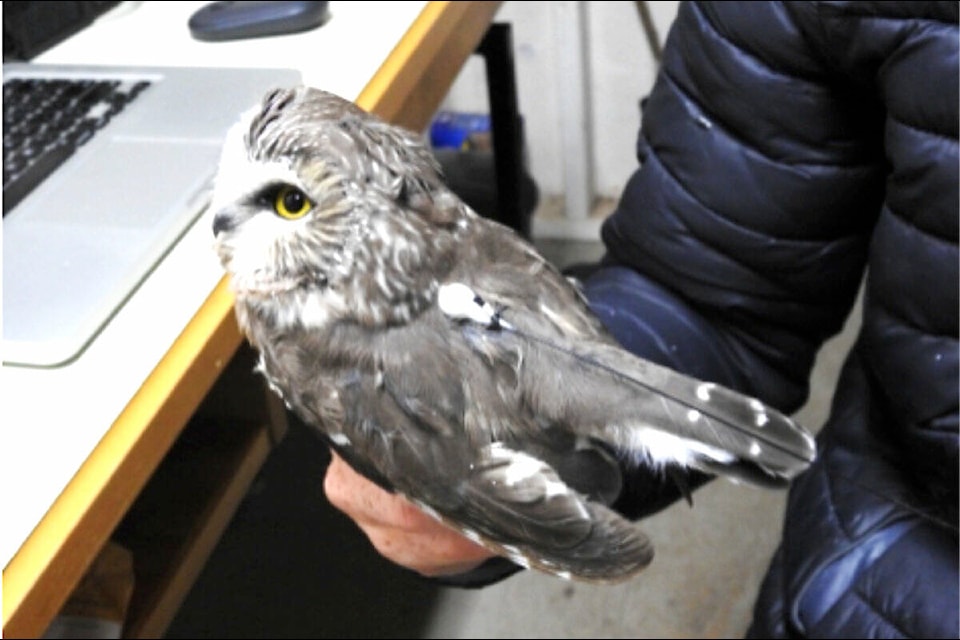By Avery Bartel
Special to the Tribune
In the spring of 2021 a group of researchers started a pilot project to study the movements of Northern Saw-whet Owls in southern B.C. using the Motus Wildlife Tracking System(Motus). Motus is a worldwide tracking system that uses tiny radio tags attached to a study species. A network of receiving stations detect the radio signal when the animals come within range (10 to 40 km).
The participants included Professor Eric Demers at Vancouver Island University, Rocky Point Bird Observatory near Victoria and the Tatlayoko Lake Bird Observatory (TLBO). After months pursuing funding proposals and permit applications, 10 Motus tags arrived at TLBO in mid-September, just in time for the start of Saw-whet Owl migration.
The tag is placed on the owl’s back where it will not impede their normal range of motion and is attached with a harness made of stretchy nylon loops that pass under each leg (see photo below). The nylon will wear through after one to two years, roughly the lifespan of the tag’s battery.
An important part of this project was setting up our own Motus tower near the TLBO. In late August, with the help of local resident Mike Smialowski, a crew of five were able to install the antennas and receiver in the Tatlayoko Valley.
A tower nearby is important to detect how long the owls stay in Tatlayoko during their migration. With one antenna facing South and the other facing North we could also learn whether the owls continue their migration south towards the coast, or backtrack and head east on the Chilcotin Plateau.
Between Sept. 24 and 30 we deployed nine of our 10 tags on Northern Saw-whet Owls (the 10th malfunctioned). There is a naturally high mortality rate among young owls so the preference is to attach tags to adults. In the end, we tagged four adults and five young ones.
With the tags deployed, we just had to sit back and wait for the tagged owls to be detected as they passed by other Motus towers. We did our first tower check on Sept. 26, and found that two owls we had tagged on the 24 had both been detected, providing us with our first data.
Read More: Bird population monitored at Tatlayoko Lake Bird Observatory
To collect the detection data someone visits the tower with a laptop to manually download the data. To eliminate this task, Smialowski is going above and beyond in setting up an internet “bridge” that will connect the receiving station to the internet for direct uploading of data. The aim is to have this in place over the winter.
Of course, there are Motus towers in other locations that may detect our owls and so far, two of our owls have been detected elsewhere. Tag 446, deployed on September 27th was detected for four consecutive days in Nanaimo, from October 12-15th. Meanwhile, tag 439 which was deployed on September 30th, went the other way and was picked up for around 10 minutes at the Stump Lake tower, south of Kamloops! Over the course of the following 10 to 15 months, we will keep an eye out for detections of our owls from other towers around the Pacific Northwest.
In 2021, the TLBO initiated a second pilot project to extend our Saw-whet Owl banding season from its previous end date of Sept. 30 to Oct. 15. With the expectation that the owl migration peaks in October, this was something that had been considered for a couple of years. Fortunately, this fall we received funding for this pilot and had great success. Owl populations tend to follow a four-year cycle and this was a high year. During September, we banded 54 owls over 10 nights. While this is a low tally compared to some owl banding operations where hundreds are banded each year, it was not far off our two previous big years of 59 (2017) and 62 (2019).
As we suspected might happen, October brought some poor weather and so we were able to band on only six of the 15 nights. But over those six nights, bander Sachi Dell and his volunteers banded a whopping 79 Saw-whet Owls! After this success we will be aiming to make mid-October the new standard end date for owl banding at the TLBO.
The programs outlined above are made possible thanks to many people and organizations but in particular they could not have been done without funding from the Public Conservation Assistance Fund (Motus Owl tagging pilot project) and Cariboo Regional District (October owl banding pilot project). The core equipment for the Motus tower was provided by Wendy Easton at Environment and Climate Change Canada. Other components were provided by Smialowski and the Tatlayoko Field Station Society (who run the TLBO).
For more information about the TLBO see https://tatlayokobirds.wordpress.com/. To explore the various Motus projects and learn more about just what Motus is see https://motus.org. Each year we must raise upwards of $7,000 in private donations to run the TLBO. All donations are most welcome and those over $20 are eligible for a tax receipt. Donations can be made directly by etransfer to: info@tatlayokofieldstation.org, or by cheque or cash to Tatlayoko Field Station Society, Box 22, Tatlayoko Lake, BC, V0L 1W0. Please make a note that the donation is intended to support TLBO 2022.
